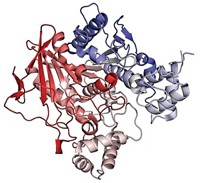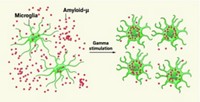Advertisement
Grab your lab coat. Let's get started
Welcome!
Welcome!
Create an account below to get 6 C&EN articles per month, receive newsletters and more - all free.
It seems this is your first time logging in online. Please enter the following information to continue.
As an ACS member you automatically get access to this site. All we need is few more details to create your reading experience.
Not you? Sign in with a different account.
Not you? Sign in with a different account.
ERROR 1
ERROR 1
ERROR 2
ERROR 2
ERROR 2
ERROR 2
ERROR 2
Password and Confirm password must match.
If you have an ACS member number, please enter it here so we can link this account to your membership. (optional)
ERROR 2
ACS values your privacy. By submitting your information, you are gaining access to C&EN and subscribing to our weekly newsletter. We use the information you provide to make your reading experience better, and we will never sell your data to third party members.
Biological Chemistry
Nanotherapy For Alzheimer’s
October 19, 2015
| A version of this story appeared in
Volume 93, Issue 41
Michael Torrice’s news report that transcranial ultrasound, coupled with intravenous injection of lipid-encased microbubbles, clears brain plaques and restores memory in mice is certainly intriguing (C&EN, March 16, page 5). As he notes in his report, this 2015 research study extends and verifies similar effects of ultrasound on another type of Alzheimer’s mouse model reported by a different team of researchers in 2014, all of which indicates noninvasive ultrasound could offer a nonpharmaceutical method to treat Alzheimer’s disease.
However, Torrice cites another investigator in this field of research who points out that Alzheimer’s patients already have disrupted blood-brain barriers. Hence any interaction of microbubbles (acoustically activated by ultrasound) with the blood-brain barrier needs to be done very carefully so as not to make matters worse for the Alzheimer’s patient.
One potential answer to the above caution could be obtained via an appropriate choice of film-stabilized microbubbles— that is, those that can also carry a suitable drug across the blood-brain barrier for localized delivery. By such means of localized pharmaceutical treatment, it may also be possible for the ultrasound intensity (acoustic power level) to be lowered even further and still provide added efficacy—resulting in even smaller chances of doing any harm to brain tissue in the patient.
More specifically, the most desirable film-stabilized microbubble agent would target Alzheimer’s-related human receptors involving certain lipoprotein receptors, most notably SR-BI, which has been found to display significantly impaired function in Alzheimer’s patients (Mech. Ageing Dev. 2012, DOI: 10.1016/j.mad.2011.11.008; Biochem. Biophys. Res. Commun. 2015, DOI: 10.1016/j.bbrc.2014.12.028; and Proc. Natl. Acad. Sci. USA 2010, DOI: 10.1073/pnas.1005888107). One candidate (drug-carrying) microbubble agent, capable of targeting (via SR-BI) the multiple-cell-type network underlying Alzheimer’s pathophysiology, is known as LCM/ND lipid nanoemulsion type (“Stable Nanoemulsions,” Elsevier, 2011). (Editor’s note: D’Arrigo is a business development contact at CCT Pharma Inc., which is commercializing technology similar to that described in this letter.)
By incorporating a small lipophilic (Alzheimer’s treatment) drug, such as edaravone (Proc. Natl. Acad. Sci. USA 2015, DOI: 10.1073/pnas.1422998112), into the above type of lipid nanoemulsion, the resulting combination therapeutic agent could target cell surface SR-BI on various cell types simultaneously for localized drug treatment. Moreover, because of the lipid-coated microbubble subpopulation existing in this type of multitasking combination therapeutic, the clinician is also provided with the possibility of substantially reducing the acoustic power levels needed for accomplishing noninvasive (transcranial) ultrasound treatment of the brain tissue, or sonoporation, if additionally desired for the Alzheimer’s patient.
Joseph S. D’Arrigo
Bellevue, Wash.
WATCH YOUR MAILBOX … ACTUAL OR VIRTUAL
Ballots for the ACS election mailed on Friday, Oct. 2, and the online polls are open. Your voice counts, so vote for the 2016 ACS president-elect and any other races on your ballot. Polls close on Oct. 30.





Join the conversation
Contact the reporter
Submit a Letter to the Editor for publication
Engage with us on Twitter